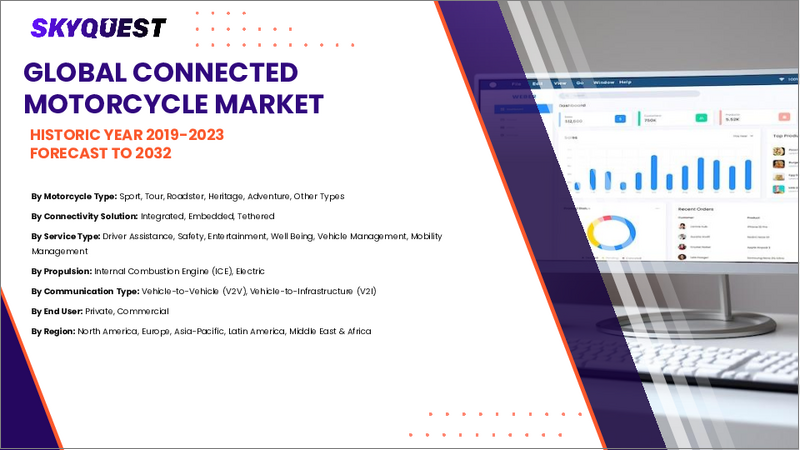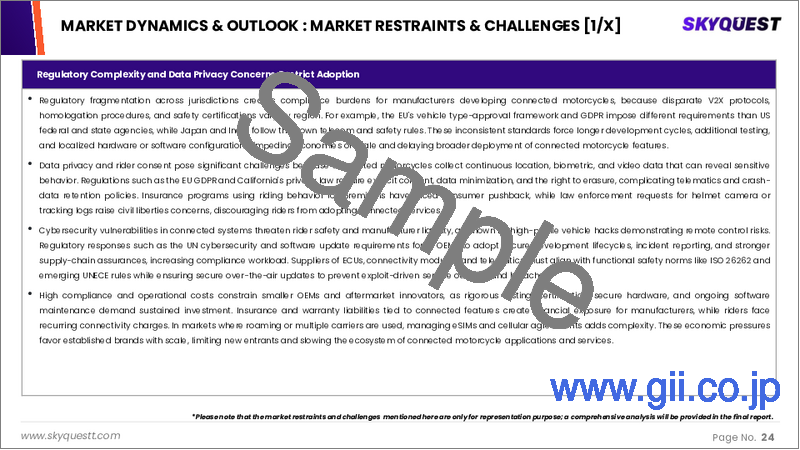|
|
市場調査レポート
商品コード
1670183
コネクテッドモーターサイクルの市場規模、シェア、成長分析:タイプ別、接続ソリューション別、サービス別、推進力別、通信タイプ別、ネットワークタイプ別、エンドユーザー別、地域別 - 産業予測 2025~2032年Connected Motorcycle Market Size, Share, and Growth Analysis, By Type (Sport, Tour), By Connectivity Solution (Integrated, Embedded), By Service, By Propulsion, By Communication Type, By Network Type, By End User, By Region - Industry Forecast 2025-2032 |
||||||
|
|||||||
| コネクテッドモーターサイクルの市場規模、シェア、成長分析:タイプ別、接続ソリューション別、サービス別、推進力別、通信タイプ別、ネットワークタイプ別、エンドユーザー別、地域別 - 産業予測 2025~2032年 |
|
出版日: 2025年02月28日
発行: SkyQuest
ページ情報: 英文 195 Pages
納期: 3~5営業日
|
全表示
- 概要
- 目次
コネクテッドモーターサイクル市場規模は2023年に1億8,178万米ドルとなり、予測期間(2025~2032年)のCAGRは45.3%で、2024年の2億6,413万米ドルから2032年には52億4,731万米ドルに成長する見通しです。
世界のコネクテッドモーターサイクル市場は、走行安全への取り組みの強化、Vehicle-to-Everything(V2X)技術の急速な採用、スマートバイクや電動バイクの販売急増によって力強い成長を遂げています。オートバイの事故率の増加は、先進ライダー支援システム(ARAS)の統合を促進し、コネクテッドモーターサイクルの採用を促進しながら、より安全な運転に貢献しています。さらに、IoTと高速通信ネットワークの拡大がV2X機能を強化し、ライダーのナビゲーションと状況認識を向上させています。持続可能性への懸念が電動バイクの需要を後押ししており、テレマティクスを搭載したスマートモデルの最近の発売が市場力学を強化すると予想されます。サイバーセキュリティリスクや初期コストの高さといった課題はあるものの、コネクテッドモビリティソリューションを推進する政府の取り組みや、欧州や北米などの地域における規制基準も、大きな成長機会をもたらしています。
目次
イントロダクション
- 調査の目的
- 調査範囲
- 定義
調査手法
- 情報調達
- 二次と一次データの方法
- 市場規模予測
- 市場の前提条件と制限
エグゼクティブサマリー
- 世界市場の見通し
- 供給と需要の動向分析
- セグメント別機会分析
市場力学と見通し
- 市場概要
- 市場規模
- 市場力学
- 促進要因と機会
- 抑制要因と課題
- ポーターの分析
主な市場の考察
- 重要成功要因
- 競合の程度
- 主な投資機会
- 市場エコシステム
- 市場の魅力指数(2024年)
- PESTEL分析
- マクロ経済指標
- バリューチェーン分析
- 価格分析
- ケーススタディ
コネクテッドモーターサイクル市場規模:タイプ別
- 市場概要
- スポーツ
- ツアー
- ロードスター
- ヘリテージ
- アドベンチャー
- その他のタイプ
コネクテッドモーターサイクル市場規模:接続ソリューション別
- 市場概要
- 統合型
- 埋め込み型
- テザリング型
コネクテッドモーターサイクル市場規模:サービス別
- 市場概要
- ドライバーアシスタンス
- 安全性
- エンターテインメント
- ウェルビーイング
- 車両管理
- モビリティ管理
コネクテッドモーターサイクル市場規模:推進力別
- 市場概要
- 内燃機関(ICE)
- 電気
コネクテッドモーターサイクル市場規模:通信タイプ別
- 市場概要
- 車車間通信(V2V)
- 車両対インフラ(V2I)
コネクテッドモーターサイクル市場規模:ネットワークタイプ別
- 市場概要
- セルラー車両間通信(C-V2X)
- 専用短距離通信(DSRC)
コネクテッドモーターサイクル市場規模:エンドユーザー別
- 市場概要
- 個人用
- 商業用
コネクテッドモーターサイクル市場規模
- 北米
- 米国
- カナダ
- 欧州
- ドイツ
- スペイン
- フランス
- 英国
- イタリア
- その他欧州地域
- アジア太平洋地域
- 中国
- インド
- 日本
- 韓国
- その他アジア太平洋地域
- ラテンアメリカ
- ブラジル
- その他ラテンアメリカ地域
- 中東・アフリカ
- GCC諸国
- 南アフリカ
- その他中東・アフリカ
競合情報
- 上位5社の比較
- 主要企業の市場ポジショニング(2024年)
- 主な市場企業が採用した戦略
- 最近の市場動向
- 企業の市場シェア分析(2024年)
- 主要企業の企業プロファイル
- 企業の詳細
- 製品ポートフォリオ分析
- 企業のセグメント別シェア分析
- 収益の前年比比較(2022~2024年)
主要企業プロファイル
- Continental AG(Germany)
- Robert Bosch GmbH(Germany)
- Panasonic Corporation(Japan)
- BMW Motorrad(Germany)
- Harley-Davidson, Inc.(USA)
- Yamaha Motor Co., Ltd.(Japan)
- Honda Motor Co., Ltd.(Japan)
- KTM AG(Austria)
- Ducati Motor Holding S.p.A.(Italy)
- Triumph Motorcycles Ltd.(UK)
- Starcom Systems(USA)
- TE Connectivity(Switzerland)
- Vodafone Group Plc(UK)
- AT&T Inc.(USA)
- Verizon Communications Inc.(USA)
- Harman International Industries, Inc.(USA)
- Ride Vision Ltd.(Israel)
- SmartHalo Technologies Inc.(Canada)
結論と提言
Connected Motorcycle Market size was valued at USD 181.78 million in 2023 and is poised to grow from USD 264.13 million in 2024 to USD 5247.31 million by 2032, growing at a CAGR of 45.3% during the forecast period (2025-2032).
The global connected motorcycle market is witnessing robust growth driven by heightened ride safety initiatives, the rapid adoption of Vehicle-to-Everything (V2X) technologies, and the surge in smart and electric motorcycle sales. Increasing motorcycle accident rates have catalyzed the integration of advanced rider-assistance systems (ARAS), which contribute to safer rides while stimulating connected motorcycle adoption. Furthermore, the expansion of IoT and high-speed communication networks enhances V2X capabilities, improving rider navigational and situational awareness. Sustainability concerns are propelling electric motorcycle demand, and recent launches of smart models equipped with telematics are expected to bolster market dynamics. Government initiatives promoting connected mobility solutions, along with regulatory standards in regions like Europe and North America, also present significant growth opportunities, despite challenges such as cybersecurity risks and high initial costs.
Top-down and bottom-up approaches were used to estimate and validate the size of the Connected Motorcycle market and to estimate the size of various other dependent submarkets. The research methodology used to estimate the market size includes the following details: The key players in the market were identified through secondary research, and their market shares in the respective regions were determined through primary and secondary research. This entire procedure includes the study of the annual and financial reports of the top market players and extensive interviews for key insights from industry leaders such as CEOs, VPs, directors, and marketing executives. All percentage shares split, and breakdowns were determined using secondary sources and verified through Primary sources. All possible parameters that affect the markets covered in this research study have been accounted for, viewed in extensive detail, verified through primary research, and analyzed to get the final quantitative and qualitative data.
Connected Motorcycle Market Segments Analysis
Global Connected Motorcycle Market is segmented by Type, Connectivity Solution, Service, Propulsion, Communication Type, Network Type, End User and region. Based on Type, the market is segmented into Sport, Tour, Roadster, Heritage, Adventure and Other Types. Based on Connectivity Solution, the market is segmented into Integrated, Embedded and Tethered. Based on Service, the market is segmented into Driver Assistance, Safety, Entertainment, Well Being, Vehicle Management and Mobility Management. Based on Propulsion, the market is segmented into Internal Combustion Engine (ICE) and Electric. Based on Communication Type, the market is segmented into Vehicle-to-Vehicle (V2V) and Vehicle-to-Infrastructure (V2I). Based on Network Type, the market is segmented into Cellular Vehicle-to-Everything (C-V2X) and Dedicated Short-Range Communications (DSRC). Based on End User, the market is segmented into Private and Commercial. Based on region, the market is segmented into North America, Europe, Asia Pacific, Latin America and Middle East & Africa.
Driver of the Connected Motorcycle Market
The connected motorcycle market is being significantly propelled by advancements in connectivity technologies, particularly the rapid deployment of 5G networks worldwide, driven by telecommunications companies. These networks provide ultra-low latency and high-speed communication, which greatly enhance the functionalities and performance of connected motorcycles. As a result, this technological evolution is positively influencing the market outlook for connected motorcycles on a global scale, fostering an environment where improved connectivity features can be seamlessly integrated into motorcycle designs and usage, ultimately leading to a greater adoption and demand for these innovative vehicles.
Restraints in the Connected Motorcycle Market
The Connected Motorcycle market faces several significant restraints primarily due to its dependence on cloud-based services and wireless communication systems, which inherently exposes these vehicles to cyber threats. Concerns about data privacy, potential hacking incidents, and unauthorized access to motorcycle control systems can deter consumers from embracing this technology. As awareness of these vulnerabilities increases, potential buyers may become increasingly skeptical, which could hinder the overall adoption of connected motorcycles. This rising apprehension surrounding cyberattacks poses a considerable challenge for manufacturers and stakeholders aiming to expand the connected motorcycle market, as consumer confidence is crucial for widespread acceptance.
Market Trends of the Connected Motorcycle Market
The Connected Motorcycle market is increasingly witnessing a significant trend towards the integration of Advanced Rider-Assistance Systems (ARAS), as manufacturers strive to enhance rider safety and improve overall driving experiences. Features such as lane departure warnings, adaptive cruise control, and collision avoidance systems are becoming standard offerings, appealing to a safety-conscious consumer base. This growing focus on ARAS not only positions connected motorcycles as superior alternatives in the market but also enables companies to differentiate their products and expand their business scope. As the demand for smart, safe riding solutions escalates, ARAS is poised to shape the future of the connected motorcycle industry.
Table of Contents
Introduction
- Objectives of the Study
- Scope of the Report
- Definitions
Research Methodology
- Information Procurement
- Secondary & Primary Data Methods
- Market Size Estimation
- Market Assumptions & Limitations
Executive Summary
- Global Market Outlook
- Supply & Demand Trend Analysis
- Segmental Opportunity Analysis
Market Dynamics & Outlook
- Market Overview
- Market Size
- Market Dynamics
- Drivers & Opportunities
- Restraints & Challenges
- Porters Analysis
- Competitive rivalry
- Threat of substitute
- Bargaining power of buyers
- Threat of new entrants
- Bargaining power of suppliers
Key Market Insights
- Key Success Factors
- Degree of Competition
- Top Investment Pockets
- Market Ecosystem
- Market Attractiveness Index, 2024
- PESTEL Analysis
- Macro-Economic Indicators
- Value Chain Analysis
- Pricing Analysis
- Case Studies
Global Connected Motorcycle Market Size by Type & CAGR (2025-2032)
- Market Overview
- Sport
- Tour
- Roadster
- Heritage
- Adventure
- Other Types
Global Connected Motorcycle Market Size by Connectivity Solution & CAGR (2025-2032)
- Market Overview
- Integrated
- Embedded
- Tethered
Global Connected Motorcycle Market Size by Service & CAGR (2025-2032)
- Market Overview
- Driver Assistance
- Safety
- Entertainment
- Well Being
- Vehicle Management
- Mobility Management
Global Connected Motorcycle Market Size by Propulsion & CAGR (2025-2032)
- Market Overview
- Internal Combustion Engine (ICE)
- Electric
Global Connected Motorcycle Market Size by Communication Type & CAGR (2025-2032)
- Market Overview
- Vehicle-to-Vehicle (V2V)
- Vehicle-to-Infrastructure (V2I)
Global Connected Motorcycle Market Size by Network Type & CAGR (2025-2032)
- Market Overview
- Cellular Vehicle-to-Everything (C-V2X)
- Dedicated Short-Range Communications (DSRC)
Global Connected Motorcycle Market Size by End User & CAGR (2025-2032)
- Market Overview
- Private
- Commercial
Global Connected Motorcycle Market Size & CAGR (2025-2032)
- North America (Type, Connectivity Solution, Service, Propulsion, Communication Type, Network Type, End User)
- US
- Canada
- Europe (Type, Connectivity Solution, Service, Propulsion, Communication Type, Network Type, End User)
- Germany
- Spain
- France
- UK
- Italy
- Rest of Europe
- Asia Pacific (Type, Connectivity Solution, Service, Propulsion, Communication Type, Network Type, End User)
- China
- India
- Japan
- South Korea
- Rest of Asia-Pacific
- Latin America (Type, Connectivity Solution, Service, Propulsion, Communication Type, Network Type, End User)
- Brazil
- Rest of Latin America
- Middle East & Africa (Type, Connectivity Solution, Service, Propulsion, Communication Type, Network Type, End User)
- GCC Countries
- South Africa
- Rest of Middle East & Africa
Competitive Intelligence
- Top 5 Player Comparison
- Market Positioning of Key Players, 2024
- Strategies Adopted by Key Market Players
- Recent Developments in the Market
- Company Market Share Analysis, 2024
- Company Profiles of All Key Players
- Company Details
- Product Portfolio Analysis
- Company's Segmental Share Analysis
- Revenue Y-O-Y Comparison (2022-2024)
Key Company Profiles
- Continental AG (Germany)
- Company Overview
- Business Segment Overview
- Financial Updates
- Key Developments
- Robert Bosch GmbH (Germany)
- Company Overview
- Business Segment Overview
- Financial Updates
- Key Developments
- Panasonic Corporation (Japan)
- Company Overview
- Business Segment Overview
- Financial Updates
- Key Developments
- BMW Motorrad (Germany)
- Company Overview
- Business Segment Overview
- Financial Updates
- Key Developments
- Harley-Davidson, Inc. (USA)
- Company Overview
- Business Segment Overview
- Financial Updates
- Key Developments
- Yamaha Motor Co., Ltd. (Japan)
- Company Overview
- Business Segment Overview
- Financial Updates
- Key Developments
- Honda Motor Co., Ltd. (Japan)
- Company Overview
- Business Segment Overview
- Financial Updates
- Key Developments
- KTM AG (Austria)
- Company Overview
- Business Segment Overview
- Financial Updates
- Key Developments
- Ducati Motor Holding S.p.A. (Italy)
- Company Overview
- Business Segment Overview
- Financial Updates
- Key Developments
- Triumph Motorcycles Ltd. (UK)
- Company Overview
- Business Segment Overview
- Financial Updates
- Key Developments
- Starcom Systems (USA)
- Company Overview
- Business Segment Overview
- Financial Updates
- Key Developments
- TE Connectivity (Switzerland)
- Company Overview
- Business Segment Overview
- Financial Updates
- Key Developments
- Vodafone Group Plc (UK)
- Company Overview
- Business Segment Overview
- Financial Updates
- Key Developments
- AT&T Inc. (USA)
- Company Overview
- Business Segment Overview
- Financial Updates
- Key Developments
- Verizon Communications Inc. (USA)
- Company Overview
- Business Segment Overview
- Financial Updates
- Key Developments
- Harman International Industries, Inc. (USA)
- Company Overview
- Business Segment Overview
- Financial Updates
- Key Developments
- Ride Vision Ltd. (Israel)
- Company Overview
- Business Segment Overview
- Financial Updates
- Key Developments
- SmartHalo Technologies Inc. (Canada)
- Company Overview
- Business Segment Overview
- Financial Updates
- Key Developments






